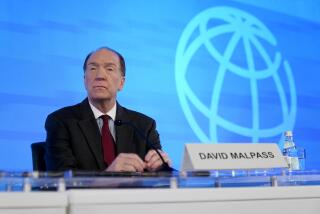A Revitalized World Bank Would Bank on New Ideas
- Share via
Barber Conable, ending his first year as the president of the World Bank, is faced with a dual crisis. The reorganization that was to have institutionalized a new vision for the bank is mired in staff protests, lawsuits and shrill charges of incompetence and favoritism. Even worse, the bank itself threatens to become irrelevant.
The purpose of the World Bank is to transfer capital from the First World to the Third World. Yet every day a much larger volume of resources flows in the opposite direction. Although the bank remains the world’s largest development institution, its importance--relative to the net flows out of the Third World--is steadily shrinking.
The Third World has always been resource-poor, but in this decade has become resource-poor er . Why?
First, the maturing debt crisis is accelerating the resource drain. Led by Citibank’s example, U.S. commercial banks are beginning to take their inevitable losses. However, these write-offs do not mean that capital is not still flowing out of the Third World--only that these countries cannot possibly pay more than they currently do. Commercial banks are cutting their losses, not increasing their loans. In Latin America, for example, the banks drew back a net of about $5 billion between mid-1985 and mid-1986.
Sub-Saharan Africa is possibly the most capital-starved area on Earth. Yet even there capital is still being exported. Even the International Monetary Fund, which is supposed to be solving the debt crisis in Africa, drew out a net of $400 million in 1986.
The second source of the World Bank’s crisis of irrelevance is the Third World’s trade deficit. The prices that developing countries pay for what they buy, compared to prices that they receive for what they sell, have worsened every year of the 1980s. Between 1981 and 1985 the cumulative terms-of-trade losses of Third World countries amounted to an extraordinary $93 billion. In 1986 the bank’s net transfer of resources to all of the developing world was only $100 million. Compare this to the net terms-of-trade loss for all developing countries the same year: $28 billion .
In response to debt and worsening terms of trade, developing countries have little choice but to ruthlessly exploit their natural resources. Under pressure to export, Third World countries have been forced to cut irreplaceable forests and hastily mine the land. Conservation has become an unaffordable luxury. The lumber, beef and commodities that are shipped daily northward deplete an already-depleted resource base. In the long run the loss of natural resources may be the most costly of the Third World’s many sources of impoverishment.
Can the World Bank stem this drain of resources?
Certainly not by itself. A World Bank with twice, or even 10 times, its current resources would still not be able to reverse the imbalance. Yet there is much that an aggressive and farsighted World Bank could do--and, perhaps more important, there is currently no other institution to do it.
Surely there will be major negotiations throughout the 1990s that will try to reconcile the debt problem and stabilize world trade. The bank needs to be a major actor in those negotiations--but it needs to speak on behalf of the world’s poor, not the First World’s commercial banks.
In the future the World Bank is less likely to be judged by the volume of dollars that it lends. It is more likely to be judged by the power of its ideas and the forcefulness of its advocacy. Yet a World Bank that finances ideas, not just projects, has to be experimenting and taking risks itself. Should, for example, the bank be supporting subsistence agriculture rather than export-oriented commodity production? Should the bank turn its focus upside down in order to support grass-roots organizations on a massive scale? Should the bank counsel default when default is the only answer? Should the bank become involved in delicate matters of social justice that affect the economic options of the poor, like land distribution and labor codes?
As the Third World’s problems get bigger, the World Bank of the 1990s is going to become a relatively smaller institution. To maintain a constructive role, Conable’s bank is going to need fresh financing, but, even more than that, it needs fresh thinking. It must demonstrate the workability of new ideas and sell them to other institutions--including Third World governments, their trading partners and commercial banks.
The World Bank’s present inability to move beyond staff reorganization has cost Conable much of the good will that welcomed him a year ago. That’s bad enough. Even more serious is the fact that he has not yet shown that he can lay the intellectual groundwork to make the bank a significant institution in the 1990s.
This is the crisis--the real crisis--that the World Bank now faces.
More to Read
Inside the business of entertainment
The Wide Shot brings you news, analysis and insights on everything from streaming wars to production — and what it all means for the future.
You may occasionally receive promotional content from the Los Angeles Times.










